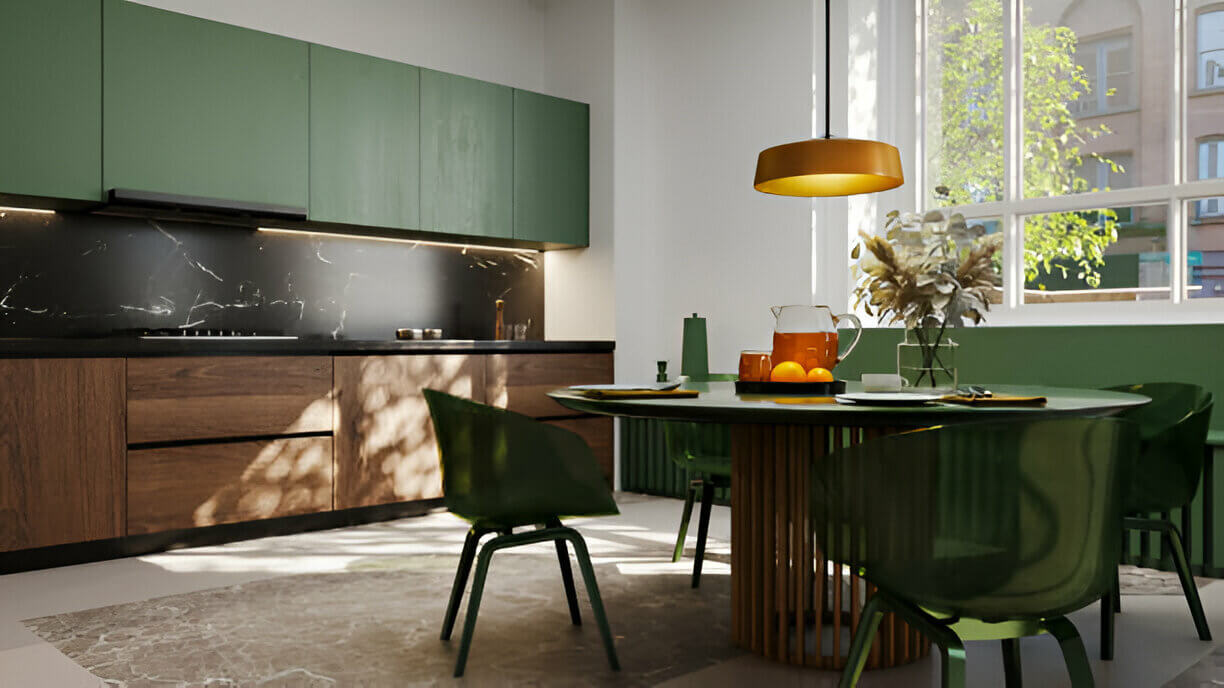The kitchen is often the heart of the home, and its design can greatly influence the overall ambiance of your living space. One of the most impactful ways to refresh your kitchen is through the use of color. Integrating color trends into your kitchen can enhance its aesthetic appeal and reflect your personal style. Here’s a comprehensive guide on how to use color trends in your kitchen effectively.

Understanding Color Trends
The Psychology of Color
Colors have a profound impact on mood and atmosphere. Understanding the psychology of color can help you create a kitchen that not only looks great but also feels right for you.
- Warm Colors: Reds and yellows are known to stimulate appetite and energy. These colors can make your kitchen feel vibrant and lively.
- Cool Colors: Blues and greens are calming and soothing. They can create a serene and relaxing environment, perfect for a space where you might want to unwind.
Current Color Trends
Staying updated with the latest color trends can give your kitchen a modern and stylish look. Several colors are making waves:
- Warm Whites and Neutrals: These colors provide a timeless and versatile backdrop, making the kitchen feel open and inviting.
- Bold and Vivid Colors: Greens, yellows, and reds are becoming popular for creating statement kitchens. These colors add personality and can be used in various combinations to achieve different effects.
- Earthy Tones and Nature-Inspired Shades: Inspired by the natural world, these colors bring warmth and comfort to the kitchen. Think of shades like terracotta, sage green, and rich browns.
Choosing the Right Color Palette
Creating Contrast
Creating contrast in your kitchen design can add depth and interest. Here are some ideas for high-contrast combinations:
- White and Dark Countertops: White cabinets paired with dark countertops create a striking and modern look. This combination is both classic and contemporary.
- Black and Light Walls: Black cabinets or islands against light-colored walls and backsplashes can make a bold statement without overwhelming the space.
Balancing Colors
Balance is key when working with color. The 70/20/10 rule is a helpful guideline:
- Main Color (70%): This is the dominant color and is usually applied to the walls, cabinets, or large appliances.
- Secondary Color (20%): This complements the main color and is used on elements like the backsplash, countertop, or accent walls.
- Accent Color (10%): The accent color adds a pop of interest and can be introduced through decor items, small appliances, or accessories.
Monochromatic Schemes
A monochromatic color scheme involves using variations of a single color. This approach creates a cohesive and elegant look. For example, different shades of blue can be used throughout the kitchen to maintain harmony while adding depth.
Implementing Color in Kitchen Elements
Cabinets and Countertops
Cabinets and countertops are significant visual elements in a kitchen and offer excellent opportunities to incorporate color trends.
- Bold Cabinet Colors: Deep navy, emerald green, and rich red are popular choices for creating a dramatic effect. These colors can make your kitchen look sophisticated and modern.
- Natural Wood and Stains: Stained wood cabinets offer a classic, durable option that brings warmth and texture to the kitchen. Opt for stains that enhance the wood’s natural grain and color.
Walls and Backsplashes
Walls and backsplashes are perfect for adding color to your kitchen without overwhelming it.
- Statement Walls: A statement wall in a bold color can serve as a focal point. It can be behind the stove, around the dining area, or even a single wall that stands out.
- Tile Options: Subway tiles, geometric patterns, and colorful mosaics can add personality to your backsplash. Choose colors that complement your overall palette.
Accessories and Fixtures
Small touches can make a big impact and are easier to change if you want to update your look in the future.
- Accents and Hardware: Brass, gold, and black hardware can add a touch of elegance and sophistication. Consider changing cabinet handles, faucets, and light fixtures to match your color scheme.
- Textiles and Decor: Curtains, rugs, and wall art are excellent ways to introduce color. These elements can be easily updated to reflect new trends.
Practical Tips for Using Color Trends
Sample and Test Colors
Before committing to a color, it’s essential to see how it looks in your kitchen’s lighting.
- Testing in Different Lights: Colors can look different under natural light, artificial light, and at different times of the day. Paint small sections and observe them throughout the day to see how the color changes.
- Small Sections First: Start by painting a small area or using peel-and-stick samples before committing to a large section. This approach allows you to ensure you love the color in your space.
Mixing Trends with Timeless Elements
While it’s exciting to incorporate trends, balancing them with timeless elements can create a more enduring look.
- Balancing Trends with Classic Design: Integrate trendy colors with classic materials and styles. For example, pair a bold color with a timeless marble countertop or classic subway tile backsplash.
- Seasonal Updates: Use accessories and small decor items to update your kitchen’s color scheme seasonally. This method allows you to stay current with trends without a significant commitment.
Conclusion
Using color trends in your kitchen can transform the space into a lively, welcoming, and stylish area. By understanding the psychology of color, staying updated with current trends, and thoughtfully incorporating colors into various kitchen elements, you can create a kitchen that not only looks fantastic but also feels like the heart of your home. Experiment, have fun with color, and enjoy the process of making your kitchen uniquely yours.



